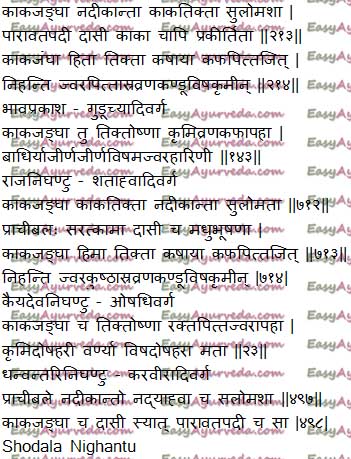Kakajangha (Peristrophe bicalyculata) – Uses, Remedies, Side Effects, Research
By Dr Renita D’Souza
Kakajangha (Peristrophe bicalyculata) is an Ayurvedic herb used to treat fever, poisoning, wounds, bleeding disorders, snakebites, worm infestation, fracture, sprains, conjunctivitis etc
Table of Contents
Home remedies
Traditional Remedies of Kakajanga
- Plant macerated in an infusion of rice is used as antidote for snake poison.
- Leaf paste is applied externally to treat bone fractures.
- In sprains and bone fracture, paste of whole plant is applied externally mixing with salt.
- In conjunctivitis, 2 drops of fresh leaf juice is poured into eyes twice a day for 2-3 days.
- Leaf extract is used in fever, cough, colds, malarial fever, flatulence in cattle
- In skin diseases its poultice is used.
- Decoction of kakajangha is mixed with honey, kills the worm affecting teeth.
- Root paste is applied over ulcerative wound heals suppuration, pain and removes bad odour.
Other Uses
- The specific smell and taste of Kakajangha plant repel away the bees, hence the honey collector applies the juice of whole plant over the body and then collects the honey.
- Used as horse fodder.
- Mucilage content of the seeds is stretched out into a fine thread on drying. This thread is used to remove foreign bodies from eyes and ears.
Qualities, uses
Botanical Name – Peristrophe bicalyculata
Family – Acanthaceae Synonyms – Dicliptera bicalyculata (Retz.) Kostel.
Medicinal Qualities Taste – Tikta (bitter), Kashaya (astringent) Virya (potency) – Cold
Actions Varnya – improves complexion
Indications Fever Raktapitta – bleeding disorders Vrana – wound, ulcers Visha – poisoning, toxic conditions Krimi – worm infestation, infection Badirya – deafness Indigestion Jirna vishama jwara – chronic recurrent fever Itching
Traditional Uses of kakajanga Tuberculosis Snake bite Bone fracture Sprains Hysteria Lecoderma Psychomotor disorder
Effect on Doshas Balances Kapha and Pitta dosha
Morphology, distribution
Morphology of Peristrophe bicalyculata It is a sub-shrub grows up to 3 – 4 feet tall. Leaves are hairy, simple, opposite and ovate in shape. Flowers are small, purple in colour. Fruits – capsule, 4 seeded. Stems are angled. Plant yields yellowish brown essential oil.
Distribution India, Myanmar, Vietnam, Tropical Africa
Sanskrit verse

Dose, pharmacology, controversy
Dose 1 – 5 grams
Pharmacological Activity of Peristrophe bicalyculata Expectorant, Analgesic, Anti-inflammatory, Anti-pyretic, Anti-bacterial, Anti-hypertensive and Anti-cancer activities.
Controversy Other herbs which are considered as Kakjangh 1. Leea hirta 2. Vitex peduncularis
Interaction with medicines, supplements
Can this be used while taking Homeopathic medicine?
Yes. This product does not react with homeopathic medicine.
Can
this medicine be continued while taking supplements like multivitamin tablets,
Omega 3 fatty acids etc?
Yes. Generally, this product goes well with most
of the dietary supplements. However, if you are taking more than one product
per day, please consult your doctor for an opinion.
With western
medicines
Seek your
doctor’s advice if you are taking this product along with other western
(allopathic / modern) medicines. Some Ayurvedic herbs can interact with modern
medicine.
If both Ayurvedic and allopathic medicines are advised together, then it is
best to take Allopathic medicine first, wait for 30 minutes and then take the
Ayurvedic medicine.
Chemistry, research, medicines
Chemical Constituents Peristrophe bicalyculata contains alkaloids, flavonoids, glycosides, steroids, saponins and tannins.
Research 1. A review article has justified the traditional use of Peristrophe bicalyculata and concluded it as a safe, highly important medicinal plant. 2. A research study on pharmacognostical and phytochemical investigation of peristrophe bicalyculata () 3. Anti-oxidant and Anti-bacterial activity A study done to evaluate the antioxidant, phytochemicals and antibacterial action of leaves extracts of Peristrophe bicalyculata against respiratory tract pathogens have concluded its significant use as antioxidant and remedy of respiratory infectious diseases. 4. Anticancer Activity – A research carried out to evaluate the anticancer activity of leaf extracts of Peristrophe bicalyculata have concluded significant anticancer activity of the methanolic ethylacetate fraction of the plant.
Ayurvedic formulations with Kakajanga Ingredient Maha Vishagarbha Taila – Widely used Ayuvedic oil to treat Vata Dosha, Sciatica, Tetanus, Stiffness in back and limbs, Tinnitis and lack of tactile sensation.
Synonyms, category, vernacular
Sanskrit Synonyms
Kakajangha, Nadikanta, Kaakatiktha Sulomasha, Paravatapadi, Dasi Kaaka, prachibala, Madhubhushan
Classical Categorisation
Bhavaprakasha Nighantu – Guduchyadi Varga
Raja Nighantu – Shatavahadi Varga
Kaiyadeva Nighantu – Aushadi Varga
Dhanvantari Nighantu – Karaviradi Varga
Shodala Nighantu – Karaviradi Varga
Names in different Languages
Bengali Name – Nasabhaga
Hindi Name – Kakajangha, Masi, Kali aghedi
Kannada Name – Cheebi Gida, Cheebera Soppu
Malayalam Name – Katou-pulcholli
Sanskrit Name – Sulomasha, Kakajangha, Nadikanta
Tamil Name – Nagananda
Telugu Name – Velama Sandhi, Chebira
Marathi Name – Ran kirayt
Click to Consult Dr Renita D’Souza










2 comments
U. Vasu
Its called ‘Velama Sandhi’ in telugu
Dr J V Hebbar MD(Ayu)Author
Thanks. I have included it in the article.